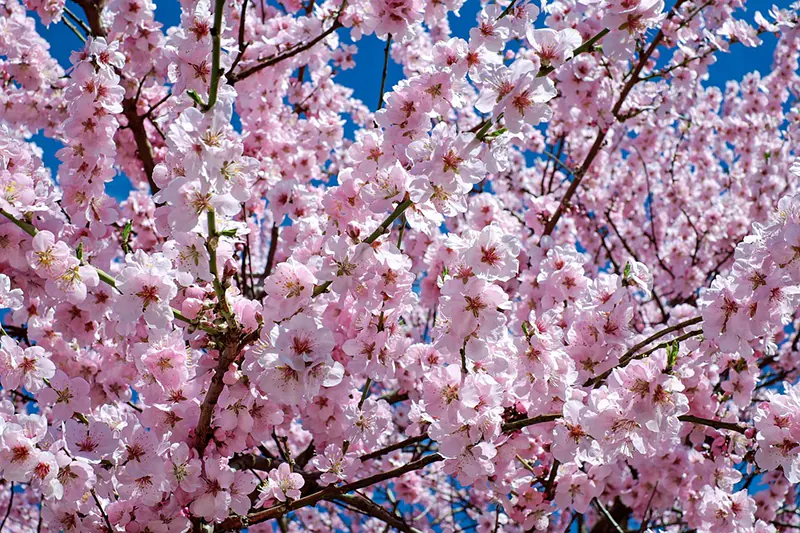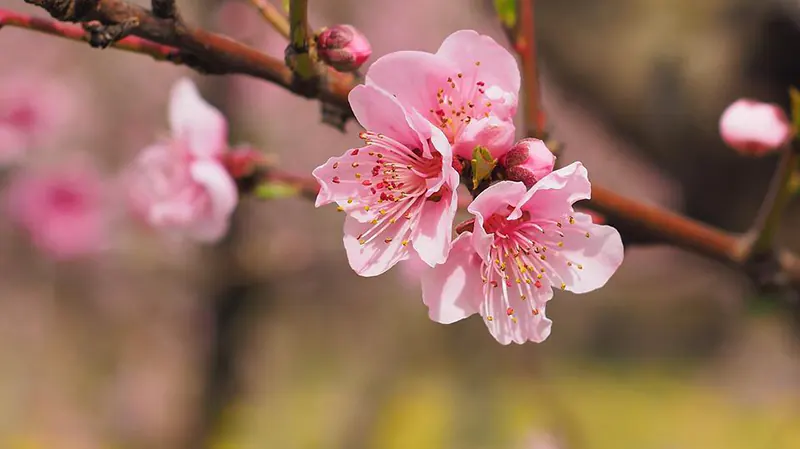How To Grow A Cherry Tree?
Cherry trees make great bonsai. You can tell them apart from other trees by their unique flowers and leaves. Since cherry trees are already beautiful on their own, growing a cherry tree into a bonsai makes it even more stunning.
If you’re interested in learning how to grow a cherry tree, use the following tips to develop your cherry bonsai tree successfully.
Understanding A Cherry Bonsai Tree
A cherry bonsai tree is a beautiful addition to any home or office. The cherry tree is known for its beautiful flowers, usually pink or red. The blossoms appear during spring and early summer.
Large cherry trees can grow up to 35 feet tall, with an average lifespan of about 25 years. They need total sun exposure and rich soil that contains plenty of moisture. They should be watered regularly during the growing season to have plenty of moisture in the soil. In addition, these trees need to be fertilized every two weeks before new growth begins in springtime.
To create a bonsai version of this beautiful plant, you will need to prune it regularly throughout its life cycle (about once per week). You should also use wire ties around each branch to stay tied into place while it grows taller over time (this will prevent breakage). Finally, make sure that there is enough space between each branch so that they do not overlap each other when they reach maturity!
How To Grow a Cherry Tree From Seed And Cutting
Growing cherry bonsai trees is a rewarding hobby that doesn’t require much maintenance. You can create your cherry bonsai tree with minimal effort from a seedling or a cutting.
Growing Cherry Bonsai Trees From Seeds
- 1. Get the seeds from a cherry tree that you want to grow as a bonsai.
- 2. Soak the seeds overnight in water.
- 3. Plant each seed in moist soil.
- 4. Place them in a sunny, warm spot and keep them watered regularly until they grow into small trees (about six months).
- 5. Transplant them into larger pots when they’re about 3 inches tall, and give them enough water until they’re established (about two weeks).
- 6. Continue giving them plenty of sun and water for another week or two until they start thriving again (this will happen once more during their first year).
Growing Cherry Bonsai Trees From Cuttings
- 1. Take a cutting from a healthy, mature cherry tree. (Note: Make sure the tip of the cut has new growth.)
- 2. Remove all leaves except for the top two or three, which should be left intact to help protect the growing bud.
- 3. Gently push the cutting into the soil in a pot or container and cover with plastic wrap to keep it moist while it grows roots.
- 4. Place your newly planted bonsai in an area that receives indirect sunlight. Keep it watered regularly until new growth appears, which can take up to six months or longer depending on how long your original cutting was left on its parent tree before being removed.

General Care
The cherry bonsai tree is a popular houseplant gaining popularity in recent years. This tree is easy to care for and does not require much attention. This makes it an excellent option for people looking for a plant that will require minimal upkeep.
The cherry bonsai tree is also relatively small, which means that it can fit in most rooms of your home. It’s best to place the cherry bonsai tree near a window where it will get plenty of sunlight. However, if there isn’t enough sunlight in your home, you can use artificial light instead. Keep reading to learn how to care for your cherry bonsai tree!
Developing A Strong Cherry Bonsai Tree
The following is a step-by-step guide to developing a strong cherry bonsai tree:
- 1. Choose the correct type of tree for your bonsai. Cherry trees are good choices for bonsai because they have small leaves. To develop a strong cherry bonsai tree, you must first decide what type of tree you want to grow. You can choose from different cherry trees:
- Yoshino Cherry Tree
- Kwanzan Cherry Tree
- Yoshino Cherry Tree (Prunus X yedoensis)
- 2. Wait until your cherry tree is at least 12 months old before beginning the process, which will help it develop strong roots and branches that can support being trained as a bonsai.
- 3. Prune the top third of your cherry tree’s branches down to one leaf per node on each branch (this will encourage new growth). Then remove any flowers or fruit produced by your cherry tree until you’re ready for it to flower again (usually around springtime).
- 4. Make sure your cherry tree gets enough sunlight every day and plenty of water during hot weather (but not too much, which could cause the root to rot). You may need to add fertilizer every month if you notice yellowing leaves or stunted growth due to the lack of nutrients in the soil.
Buying A Cherry Bonsai And Caring For It
You can also consider buying a cherry bonsai. As mentioned earlier, it doesn’t take much work to care for this plant, but it does require some patience and attention. The first thing you need to do is make sure that you have an area in your home that gets plenty of sunlight. This can be a window sill or even on top of your fridge if it gets enough sunlight throughout the day. You’ll also want to make sure that your plant has access to water every day, but not too much water so that it stays moist but not soggy.
Choosing The Right Cherry Bonsai Plant Pot
Choosing the right cherry bonsai plant pot is an essential step in caring for your cherry bonsai tree, but it is also one that often gets skipped over. While it may seem like a minor detail, choosing the right pot can significantly impact how well your cherry bonsai tree grows and how long it lives.
The first thing to consider when choosing a pot for your cherry bonsai tree is the size of the pot. You want to make sure that your pot has enough room for your tree to grow, but not so much room that it will outgrow its small root system before it can mature.
Cherry trees also need good drainage, so look for terracotta pots or ceramic pots with holes to allow water to drain out of the bottom without pooling around the base of the plant or sitting in stagnant water, which can lead to root rot.
Picking The Right Fertilizers
Since cherry trees are native to China, they’re much more sensitive than other species to certain fertilizers. When growing cherry bonsai, it’s important to use fertilizers with the correct mineral ratios for this type of tree.
If you’re growing your cherry bonsai indoors, you’ll want to add nutrients every two weeks during its growing season (approximately March through October). You’ll also want to make sure that there isn’t too much water in the soil. Too much water can cause root rot or fungal diseases that are harmful to your plant!
It’s essential to balance feeding your plant and not overfeeding it. Here are some tips for picking the right fertilizer:
- Look for something organic. This means that it’s made from natural ingredients like fish meal, seaweed extract, or bone meal rather than synthetic chemicals like ammonium nitrate or urea.
- Choose a slow-release formula if possible. These formulations release nutrients slowly throughout the growing season rather than all at once, which can shock your plant into thinking it needs more nutrients than it actually does.
- Check whether or not the product has any added ingredients besides nitrogen (N), phosphorus (P), and potassium (K). Many fertilizers also include calcium (Ca) and magnesium (Mg), which are critical to plant growth but should be limited in their application so as not to cause nutrient imbalances in the soil.
Using The Right Tools
Bonsai trees require a lot of attention, but they’re also very rewarding. The key to keeping your bonsai healthy is using the right tools for the job.
The first thing you’ll want to invest in is a pair of pruning shears. There are many different styles and types of shears available, but what you’ll want is something that has sharp blades and will cut cleanly through the branches of your tree without damaging them or causing too much bleeding.
You’ll also want a stake for your tree so that it doesn’t fall over when you’re not watching it closely. A good stake will be made from wood and won’t have any sharp edges that might damage your tree’s roots as they grow over time.
Finally, don’t forget about the soil! You’ll need plenty of soil so that your tree can grow adequately but not too much so that it gets too heavy at the top, where it meets with water droplets during rainfall seasons (if applicable).
Position Of The Plant
The cherry tree should be placed in indirect sunlight, which helps it grow and bloom. The tree should be situated so that its trunk faces eastward toward the rising sun. This allows it to absorb the most sunlight each day.
The soil should be kept moist but not wet or overly dry. The soil should be able to hold water without becoming waterlogged. If you’re watering your plant frequently and still seeing signs of dryness, consider moving it to a slightly lower location where there’s more shade and less sun exposure.
Watering The Cherry Bonsai
Watering the cherry bonsai is a delicate process. You don’t want to overwater, but you also don’t want to under-water it. The cherry bonsai needs about one inch of water per week. This can be done by either watering your plant once or twice a week to keep the soil moist. If you have a watering can with a fine mist, you can spray down your plant every day if you like; however, this method is not recommended for most people because it takes too much time and effort to do correctly.
Pruning The Bonsai
Pruning the cherry bonsai is a great way to keep it healthy and beautiful. First, you’ll want to select the right time of year for pruning your cherry bonsai. You should only prune your cherry bonsai during their dormant season, usually during the winter months. This will allow them to grow new branches and leaves without being damaged by the sun’s rays.
Next, you’ll need to choose the right tools for cutting the branches on your cherry bonsai tree. Ideally, you would use a pair of sharp scissors or clippers with a curved blade that can reach tight spaces without damaging them too much. Finally, don’t overdo it when pruning your cherry bonsai—you want it to look lush and complete rather than sparse and scraggly!

Wiring The Bonsai
- Choose a location for your cherry bonsai and make sure it is protected from direct sunlight.
- Water the tree thoroughly to make sure it is moist before wiring it.
- Prepare all the tools you need for wiring, including wire cutters, pliers, and twine or thread.
- Set up a work area with a flat surface and plenty of light to see what you’re doing clearly.
- Wire one branch at a time, starting at the top and working your way down to the bottom of the tree’s trunk; if there are multiple branches at one point (such as with the main branch), do not wire them all together or they may break off when they grow too heavy for their support system (instead, wire each branch individually).
Cherry Bonsai Tree Care Handy Tips
- Use a spray bottle to mist your cherry bonsai tree’s leaves every day. The water helps keep the leaves healthy and shiny and helps prevent them from drying out in the sun.
- Feed your cherry bonsai tree twice a week with a well-balanced fertilizer.
- If you want to make sure that your soil doesn’t dry out, use a humidity tray under its pot. Place rocks or pebbles in the bottom of the tray, so they don’t get wet and raise the tray above the bottom of your pot so that water won’t pool around its base.
Soiling And Re-Potting
Step 1: Remove the tree from its pot. You’ll want to keep the tree’s soil intact so it doesn’t break apart or get lost while working on your project. Use a tool like a chopstick or a pencil to loosen the soil around the trunk of your tree. Then take your hands and gently pull up on the roots, so they’re no longer anchored in place.
Step 2: Prepare your new pot. Make sure that it is at least two inches wider than your current pot. This will allow room for growth and give your tree plenty of space to spread out as it grows older.
Step 3: Place some fresh soil in the bottom of your new pot, then place some rocks or gravel over the top (this helps prevent root rot). Now place your cherry tree into its new home!

How To Prevent Pests And Diseases?
Preventing pests and diseases in a cherry bonsai tree is essential to maintaining your plant’s health. The most common problems are insects, such as slugs and snails, fungal diseases, leaf spots, and bacterial infections, such as rot.
To prevent these problems, keep the soil moist but not soggy, check for signs of pests or disease regularly, spray with water to keep down dust, prune away dead branches, and repot every two years.
Conclusion
We hope you were able to learn something valuable from these tips on how to grow a cherry tree, and we encourage you to try them out. The best thing about growing a tree is the satisfaction of watching it come to fruition and being able to tell the history of its development because you have been there for each stage.







